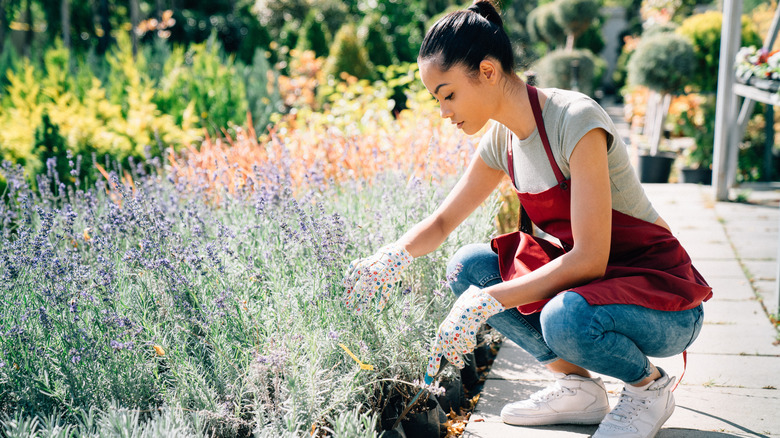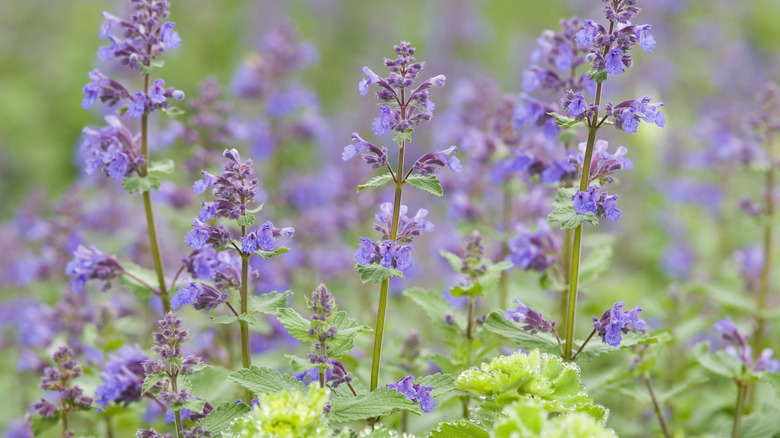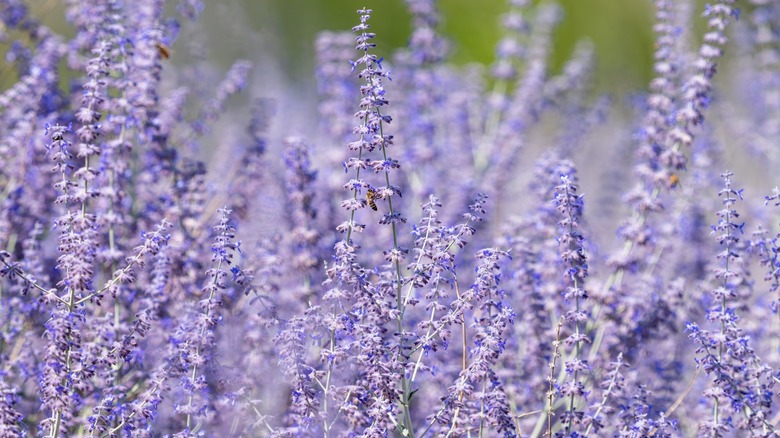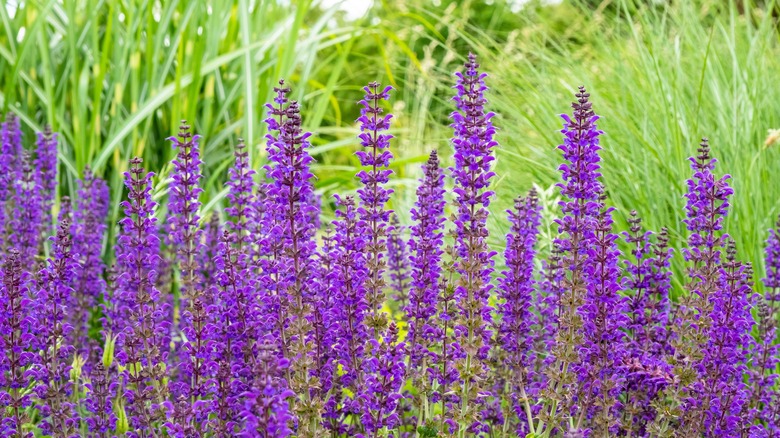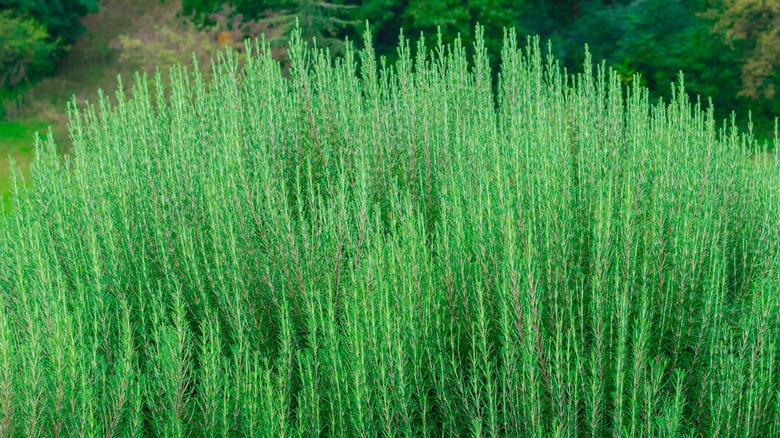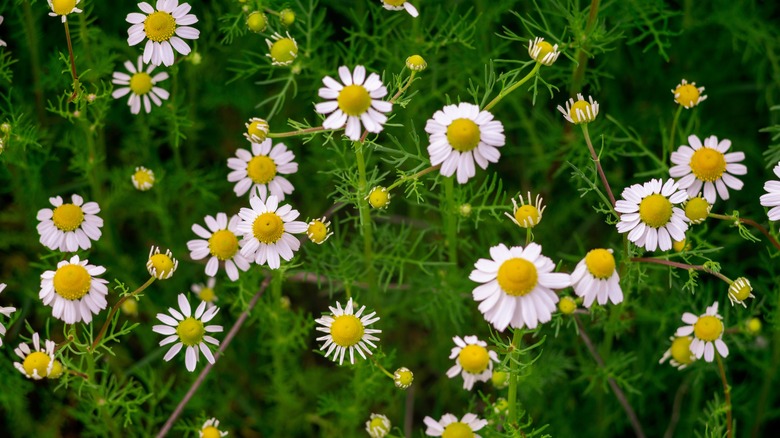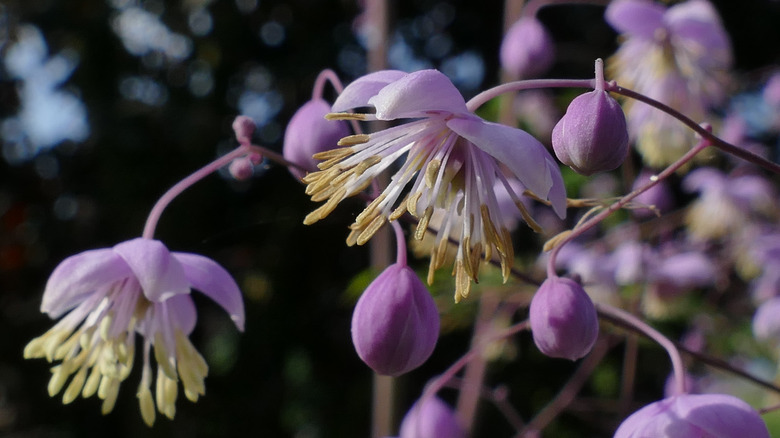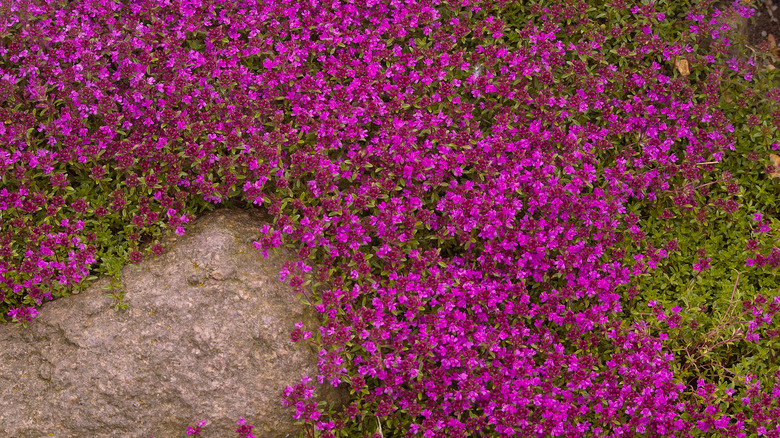Stunning Alternatives To Lavender That You Can Grow In Your Garden
Lavender is a fragrant and attractive perennial with distinct, namesake-colored blooms and numerous culinary and medicinal uses. However, growing and caring for lavender isn't always easy. It demands very specific climactic conditions and doesn't thrive in overly hot, cold, wet, or dry regions. It also doesn't like clay and acidic soil. If you attempt growing lavender anywhere outside of Mediterranean climate zones, you'll find yourself struggling to keep this beloved plant happy.
Fortunately, there are several alternatives to lavender that can grow in more diverse climates and soils. Many of these resemble the plant visually; some only share its striking color, while others don't look like lavender at all but are good options for gardens with acidic soil. Below, we've hand-picked seven diverse lavender substitutes to suit a range of USDA hardiness zones, soil types, and aesthetic preferences. Despite these plants' varied characteristics, each adds a breathtaking splash of color and character to your garden.
Catmint is an aesthetically-similar but hardier option than lavender
Catmint (Nepeta x faassenii) resembles lavender at a glance. Like lavender, it's a bushy, herbaceous perennial with delicate purple blooms and is often used as a border or pathway-edging plant. That said, catmint is a far hardier alternative to lavender and a more suitable choice for gardens in colder, hotter, drier, or wetter climates. Where lavender is only hardy in zones 5-8 — which makes much of the northern U.S. an unsuitable habitat for the plant — catmint thrives in zones 3-8. Catmint also tolerates various soil conditions better than lavender. For example, you can grow catmint in clay soils (which have a heavy presence in the southern and eastern states), provided you do your best to promote drainage. Meanwhile, lavender is more sensitive to the moisture clay retains. At the same time, catmint is more drought-resistant than lavender, so it's an excellent alternative for regions with long dry spells (or if you prefer low-maintenance plants in your garden).
Growing catmint is easy. If growing the plant from seeds, it's recommended that you sow in the spring well after the last frost. Otherwise, you can let the seeds germinate in containers earlier in the season, then transplant them into the soil outdoors after frosts cease to return, as late as the first weeks of fall. The plantings prefer well-drained soil but need frequent watering until they mature. Full sun works well for catmint, but partial shade is fine, too.
Russian sage is a lavender alternative for hotter climates
Russian sage (Perovskia atriplicifolia) is a herbaceous perennial with delicate, light indigo blooms similar in color to lavender's. The plant is a bit larger and lacks lavender's citrusy-sweet scent, but its leaves have a strong menthol aroma that makes them a good candidate for potpourri. Russian sage is hardy in USDA zones 4-9 (versus 5-8 for lavender), which means this perennial is a fitting substitute for lavender in hotter and colder climates. It'll thrive as far south as Florida and as far north as Minnesota. Moreover, Russian sage is better equipped to deal with moist soils and high humidity — both of which are harmful to lavender. This characteristic makes Russian sage an excellent alternative in humid regions like those on the coast of the Gulf of Mexico.
Before you plant Russian sage in your garden or backyard, allow the seeds to germinate in indoor containers and wait out the final frosts. Then, transplant them to a sunny, well-drained spot with slightly alkaline or neutral soil (like lavender, Russian sage does not fare well in acidic soil). Alternatively, sow the seeds before the start of fall. Just be sure to give the plants enough time to germinate and mature a bit before the frosts set in — two months should be long enough. Although Russian sage does not like overwatering, the soil should be kept consistently moist while the plantings are young. There's no need to fertilize your Russian sage plants, as they'll do just fine in poor soil.
Perennial salvia is better-suited for clay soils than lavender
Perennial salvia (Salvia nemorosa) is a herbaceous perennial with rich, exquisite blooms that come in purple, pink, red, blue, and white colors, depending on the cultivar. The plants' bushy nature, slender stems, and delicate blooms resemble lavender's, although salvia flowers are generally larger. But what makes this salvia such a resilient perennial alternative to lavender is its ability to tolerate clay — a soil type lavender loathes. While lavender's roots quickly rot when exposed to moisture-laden clay, perennial sage thrives in it as long as you don't overwater. Salvia's hardiness in USDA zones 3-9 makes it a good fit in some of the nation's most severe climates. For instance, these plants are perennial in several parts of Alaska! At the same time, Salvia can grow year-round in Texas. This remarkable hardiness makes perennial salvias a no-brainer if you've been struggling to grow lavender due to adverse soil conditions or extreme weather.
It's recommended to plant perennial salvia seeds about 14 weeks before you transplant them outdoors. Water the soil through the container's bottom and place it in a sunny spot. Doing so gives the plants light and keeps the soil warm to aid germination, which should be completed in a month or so. After the final frost, transplant the seedlings to your garden — again, a sunny location works best. Don't over- or under-water the plants, and ensure adequate drainage for the soil (especially if there's a high clay content).
Rosemary is a taller, lusher lavender substitute
Rosemary (Salvia rosmarinus) and lavender belong to the same family, Lamiaceae. Both are herbaceous perennial plants with needle-shaped foliage and fragrant blooms that come in blue and purple colors. Both have culinary and medicinal uses. But if you're choosing a bushy plant to add ample greenery — or privacy — to your garden, rosemary may be the more fitting option. That's because rosemary plants grow significantly larger in height and width than their lavender counterparts. Where lavender grows between 1 and 3 feet tall (depending on the cultivar), Rosemary shrubs reach heights of over 10 feet with proper care and good growing conditions. That said, rosemary is the more delicate, warmth-loving plant that's hardy in USDA zones 7-11 and won't survive in the colder regions of the U.S.
Seeds take a while to germinate, and you'll have a long wait for the plants to mature, but starting with young plants speeds up the process. Once frosts no longer threaten your garden, you can plant rosemary in soil with adequate drainage and ample sun, with about 20 inches between plants. You'll have to water your young rosemary plants frequently. On the other hand, mature plants can go without water for long periods as long as you're not in a drought. If you're caring for a rosemary in a pot, check the soil often and give water when it's dry. Likewise, potted plants need fertilizer between blooming seasons, whereas these garden-planted peers don't mind poor soil.
Roman chamomile is a soothing aromatherapy substitute for lavender
Much like lavender, Roman chamomile (Chamaemelum nobile) is well-known for its calming properties. It's also a herbaceous perennial, but the short, slender plants and white-petaled blooms bear little semblance to lavender. Even so, if you're looking for an attractive, low-maintenance plant that can also be used in soothing aromatherapy, Roman chamomile is a great alternative to lavender. It's also hardier. Where lavender won't thrive north of USDA zone 5 or south of zone 8, Roman chamomile is hardy in zones 4-9. This means you can grow Roman chamomile as a perennial in regions as extreme in climate as south Texas and Minnesota — both of which are inhospitable for lavender.
It's recommended to plant Roman chamomile during the later, warmer part of spring when the soil is sufficiently warm and frost is no longer a hazard. You can throw the seeds onto the soil and leave them exposed to the sun, as light is essential for germination. You'll want to keep the seedlings in a sunny spot as they grow and mature. The young chamomile plants will also need frequent watering, ensuring the soil drains well. Likewise, don't allow weeds to flourish in your flower beds, as they will starve the soil of nutrients and weaken your chamomile. Once the plants have matured, they need little maintenance apart from the occasional watering during prolonged dry conditions.
Meadow rue is a lavender alternative for acidic soil
Meadow rue (Thalictrum) is a herbaceous perennial with tall stems, dainty petals, long, quaint filaments, and an affinity for acidic soil — a habitat lavender can't tolerate. If you live along the Eastern Seaboard or the Pacific Northwest, high soil acidity is a hurdle on your path to growing lavender. Consider planting meadow rue in your garden instead. Not only will you be rewarded with unique, picturesque blossoms in the spring and summer, but you'll have a hardy plant that's also easy to maintain. Meadow rue thrives in hardiness zones 3 to 9. These areas touch much of the contiguous United States, including every region with acidic soil.
To plant meadow rue, sow the seeds right in the soil either in the spring or early fall. Choose a location with partial shade in warmer climates and full sun in cooler regions, and keep the soil moist in the summer months. Adult plants need little maintenance apart from occasional pruning to encourage new blooms. Some meadow rue cultivars grow as tall as 8 feet; if your plant reaches these heights, you'll have to stake it to keep it upright.
Creeping thyme is a hanging and ground cover alternative to lavender
Creeping thyme (Thymus praecox) is a semi-woody perennial groundcover that adds a touch of purple to your garden, much like lavender. But instead of presenting its blooms on long, slender stems, creeping thyme is like a carpet that spreads over parts of your lawn or hangs down stone walls. So, if you're enthralled by the color of lavender's blooms but have more use for a ground cover or hanging perennial, consider creeping thyme instead. It's a hardy, easy-care plant, too. It thrives in USDA zones 4-9, is deer-resistant, and tolerates most soil types as long as the soil drains well. That said, like lavender, creeping thyme does prefer neutral-to-alkaline soil.
If you're planting creeping thyme from seeds, it's recommended to sow them in your garden well after the last frost. If you want them to germinate in indoor containers, you can plant the seeds earlier in the season. Germination takes up to three weeks. When you're ready to transplant your creeping thyme outdoors, find a spot that gets full sun and plant the seedlings up to 12 inches apart. Water your young plants regularly, but make sure that the soil doesn't become marshy, as standing water could cause root rot.
